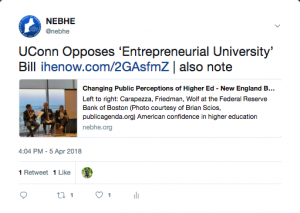
Tweets, despite their limited characters, can offer some pretty telling narratives. In May 2017, we ran a piece titled Real Tweets, Fake News … and More from the NEJHE Beat, and then followed up in November with Chance of Tweetstorms. We noted that every NEJHE item automatically posts to Twitter, but that we also use Twitter to disseminate interesting news or opinion pieces from elsewhere. These tweets are often juxtaposed with something NEBHE has worked on in the past and sometimes presented with an added comment.
The narrative this time, for better or worse, seems to center on austerity: the tension over efforts to make higher ed itself more relevant and also cheaper.
Consider some of the most recent dispatches:
UConn Opposes ‘Entrepreneurial University’ Bill https://ihenow.com/2GAsfmZ | also note /nejhe/changing-public-perceptions-of-higher-ed/
No doubt, entrepreneurial leaders have recharged many a middling institution with new “value propositions” and so on. But as Public Agenda President Will Friedman told a NEBHE panel this spring, American confidence in higher education began waning at just the time when people began to see colleges as more concerned about their bottom lines than about education and making sure students have a good education experience.
Moreover, austerity can come too late for institutions like Mount Ida College. The Newton, Mass. college announced with hardly any warning this spring that it will close for good at the end of the semester.
As we retweeted …
After Mount Ida, what should a sustainable future for higher ed look like? https://www.bostonglobe.com/opinion/2018/04/26/after-mount-ida-what-should-sustainable-future-for-higher-look-like/TY9YP3MCAWsSChIDmRovQP/story.html?event=event25 … via @BostonGlobe #HEIC
Immediate concerns ran to: why didn’t Mount Ida let its students, faculty and staff know earlier about the college’s vulnerabilities … especially since it was laying on the positive marketing right till the end? Also, why would UMass Amherst emerge as the savior of the jilted students, rather than the closer-by, but perennially neglected, UMass Boston?
The closing also offered a powerful reason to re-envision NEBHE’s dormant, but obviously timely, Higher Education Innovation Challenge … for the hashtaggers out there, #HEIC. The idea behind the initiative was to help institutions adapt models to rein in costs and pass savings on to students—and given projections of lagging enrollment, avoid closure.
The anxiety behind NEBHE’s #HEIC is only heating up. For example, see:
Wheelock Merger Results in Layoffs https://www.bu.edu/today/2018/wheelock-merger-results-in-layoffs/ … #HEIC
Atlantic Union College submits closure plan http://www.wbjournal.com/article/20180430/NEWS01/180439996/atlantic-union-college-submits-closure-plan#.WueNiauLwpQ.twitter … #HEIC
College of St. Joseph faces potential closure | small college @nebhe #HEIC saw among vulnerable early on http://www.rutlandherald.com/articles/college-of-st-joseph-faces-potential-closure/ … see http://www.nebhe.org/innovation-challenge/overview/ … and http://www.nebhe.org/thejournal/the-future-is-now-first-generation-students-community-engagement-and-innovative-institutions/ … #nejhe
The reasons are clear enough. Higher ed faces a “perfect storm” of runaway costs, enrollment pressures and a general lack of financial “sustainability”—just the stuff a reworked HEIC could address.
In the meantime, NEBHE is also working to help higher education institutions (HEIs) avoid such a fate. Consider the NEBHE-RSM University Executive Lunch Briefing held earlier this week on “Collaboration or Closure? The Landscape of Strategic Alliance and Mergers in Higher Education.”
Fascinating @nebhe discussion of Collaboration or Closure? The Landscape of Strategic Alliance and Mergers in Higher Education
Michael Goldstein, senior counsel at Cooley LLP, told the 90 or so gathered leaders that the demise of HEIs has been predicted at least since the rise of the internet. Most institutions are not at the edge of the cliff, he told the presumably nervous audience, but many see the cliff and don’t know what to do about it. Evoking New Hampshire’s “Live Free or Die” slogan, Goldstein dispelled the notion that higher education institutions must merge or die. There are a range of options such as partnerships and alliances for the institution to consider before death is at its door.
****
Immigration is another key NEBHE issue with limited characters. The stranding of DACA students not only pulls heartstrings, but also adds to a xenophobic environment that threatens a country and a region whose cultural and economic success is built on immigrants. There is occasional hope. For example, thanks to the persistence of NEBHE delegate and Connecticut state Rep. Gregory Haddad and others:
Financial aid for ‘dreamers’ becomes a reality in Connecticut https://ctmirror.org/2018/04/25/financial-aid-dreamers-becomes-reality-connecticut/ … via @ctmirror | http://www.nebhe.org/thejournal/back-in-the-shadows-the-daca-saga-continues/ … #nejhe #statecapitalnotes,
****
NEBHE’s chief focus these days is its Commission on Higher Education & Employability. Chaired by Rhode Island Gov. Gina M. Raimondo, the 50-member commission invested 11 months in public meetings and working group sessions exploring New England employers’ concerns about a lack of qualified, skilled workers, particularly in rapidly changing, technology-intensive and growth-oriented industries. The commission’s goal is to increase the career readiness of New Englanders. Its challenge is exacerbated by a decline in the traditional working-age population in the New England states.
We’ve connected a lot of tweets with the commission’s work (#CHEE, hashtaggers) and the region’s demographic challenges … and recently retweeted a piece from a place that can seem synonymous with work.
A view of work and skills from a place that knows a lot about both: Lowell, Mass. | http://www.nebhe.org/programs-overview/commission-on-higher-education-employability/updates/ … Students are being prepared for jobs that no longer exist. Here’s how that could change. https://www.nbcnews.com/news/us-news/students-are-being-prepared-jobs-no-longer-exist-here-s-n865096 … via @nbcnews #CHEE
****
Tweets can also touch on the more human side of New England higher education. Consider summer reading. A bane for some students, it is a fascinating way to get students thinking about key issues. Olin College of Engineering chose Hidden Figures: The American Dream and the Untold Story o f the Black Women Mathematicians Who Helped Win the Space Race, in part to point to an under-discussed example of diversity in STEM. Recently …
St. Mike’s picks Hamilton the Musical as first-year Common Text https://prn.to/2GYqnnn
****
We also killed two birds with one stone, recently. Former Southern Vermont College President Karen Gross shared with us two problems she saw in higher education. Problem #1 was that college students, despite their impressive activism, especially around the issue of guns, were too apolitical, especially when it came to voting: Less than 50% voted in the 2016 election. Problem #2 was that the ubiquitous college rankings that guide prospective students’ views of colleges and universities carry a range of perverse incentives such as rewarding institutions that look more selective because they reject as many students as possible and those that reap advantages on measures of retention and alumni giving by avoiding nontraditional students.
Gross proposed ranking colleges based on the share of their students who cast ballots.
NEJHE NewsBlast, April 18, 2018 | Ranking Colleges Based on the Share of Their Students W… https://conta.cc/2HbKafZ
Tweets also offer us a way to report on discussions in the field such as those at LearnLaunch’s sixth Across Boundaries conference. The Boston gathering brought together 1,500 educators, entrepreneurs, investors and others interested in driving innovation to transform learning and increase achievement using digital technologies.
Among other things, LearnLaunch explored Blockchain as it relates to “reverse transfers” as a verifiable third-party audit of learner’s accomplishments from dozens of issuers of credentials for learners.
Blockchain could dovetail with two of the key issues taken up earlier in this column: backstopping students from institutions that go out of business and helping employers better understand what learning jobseekers have completed.
As we noted, “tweets can be abused, even by presidents,” but if connected wisely, they can offer a compelling, if clipped, narrative of what’s important in New England.
John O. Harney is executive editor of The New England Journal of Higher Education.
This piece was cross-posted at JOH NEJHE.
[ssba]
